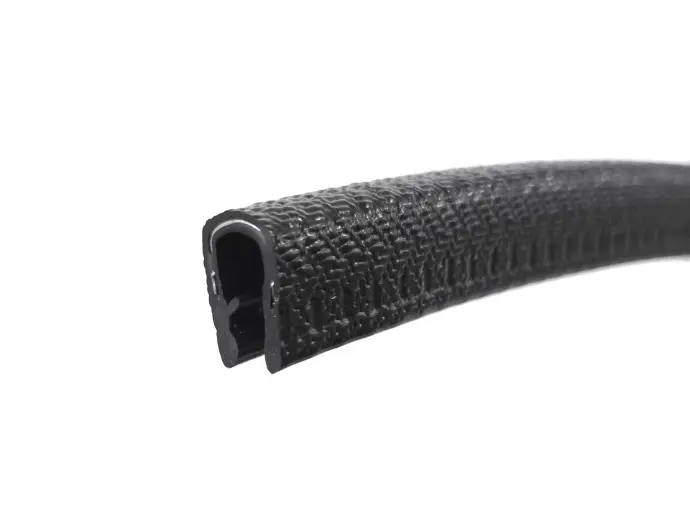Solar panels themselves are engineered to last 20–30 years, but the supporting components — such as the rubber seals and trims that protect frames, joints, and electrical enclosures — must also withstand the same period of outdoor exposure. If these rubber parts deteriorate prematurely due to sunlight, moisture or temperature extremes, it could result in more regular replacements.
One of the most relevant standards is TS EN ISO 4892-2, which uses xenon-arc lamps to simulate the effects of years of outdoor weathering in a controlled laboratory setting. Two of our metal reinforced clip-on edge trims, commonly used to protect the edges on solar panel frames, has been tested to this standard and achieved the highest possible grey scale rating of 5. For solar panel farm installers and operators, this result translates directly into confidence in long-term reliability.
What is TS EN ISO 4892-2?
Solar farms place materials under constant attack from environmental factors: UV radiation from sunlight, heat build-up under glass, condensation at night and seasonal weather extremes. Natural testing outdoors takes years before meaningful data emerges. TS EN ISO 4892-2 offers a solution by accelerating weathering in the laboratory.
This international standard defines how to expose materials to xenon-arc lamps, which reproduce the solar spectrum — including the ultraviolet (UV) wavelengths that are most damaging to polymers and elastomers. By carefully controlling light intensity, temperature, humidity and water spray cycles, the test replicates real-world outdoor conditions in a compressed timeframe.
Once exposure is complete, the tested material is compared to its unexposed reference. The assessment uses a grey scale rating system (defined by ISO 105-A02) to measure the degree of visible colour change.
Scale runs from 1 to 5:
- 5 = no visible change (best possible performance)
- 1 = severe change (poor performance)
Intermediate ratings such as 4–5 indicate slight but still noticeable differences.
Both ET57 and ET4109 seal achieved a grey scale rating of 5. In practical terms, that means even after being subjected to intense simulated sunlight and moisture cycles, there was no perceivable change in colour or surface appearance.
It’s important to note that a grey scale 5 does not guarantee that all performance properties remain unchanged. However, in elastomeric materials like rubber, colour fading and cracking often result from the same degradation processes. A material that resists visual change is usually resisting structural damage as well.
Please see the downloadable Material Datasheets for both of our UV rated edge trims.
Xenon-Arc Lamps vs Natural Sunlight
The choice of xenon-arc lamps in ISO 4892-2 testing is deliberate. Unlike narrow-band UV lamps, xenon-arc sources produce a broad spectrum of light that closely matches natural sunlight, including:
- Ultraviolet (UV, <400 nm): the most aggressive portion of sunlight for breaking down polymer bonds.
- Visible light (400–700 nm): ensuring that colour stability is realistically evaluated.
- Infrared (IR, >700 nm): contributing to heating effects that accelerate chemical changes.
Filters are used to adjust the spectrum depending on whether exposure should mimic direct outdoor daylight or sunlight through glass, both relevant for solar installations.
The lamps operate at controlled irradiance levels — higher than typical natural sunlight — to accelerate degradation without introducing unrealistic conditions. Moisture cycles, including water spray or condensation, are added to simulate dew, rain and humidity.
In short, the test doesn’t just shine UV on a material; it recreates the complex interplay of sun, heat and moisture that solar farm seals will face daily.
Support From Seals Direct
For solar panel farm operators, developers and installers, the long-term durability of every component is equally important. Rubber seals and edging trims may be small compared to photovoltaic modules, but they are important in protecting the underlying structure of the frames.
Our tested metal reinforced edge trims are compliant with TS EN ISO 4892-2 and offers proven resistance to UV, sunlight and weathering. This means there is no visible deterioration after accelerated xenon-arc testing, confidence in long-term seal integrity and reduced maintenance and replacement costs. When planning a solar installation designed to deliver energy for decades, specifying components with this level of durability is a smart investment.
At Seals Direct, we have over 50 years of experience supplying seals, gaskets and specialist rubber products to a wide range of industries, including solar farms and other outdoor sectors. We understand that quality and reliability matter, especially when it comes to protecting a large-scale investment.
You can give us a call on 01425 617722 or contact us online to discuss your requirements. Our friendly and knowledgeable team is always happy to offer advice and recommend the best product for your application.

